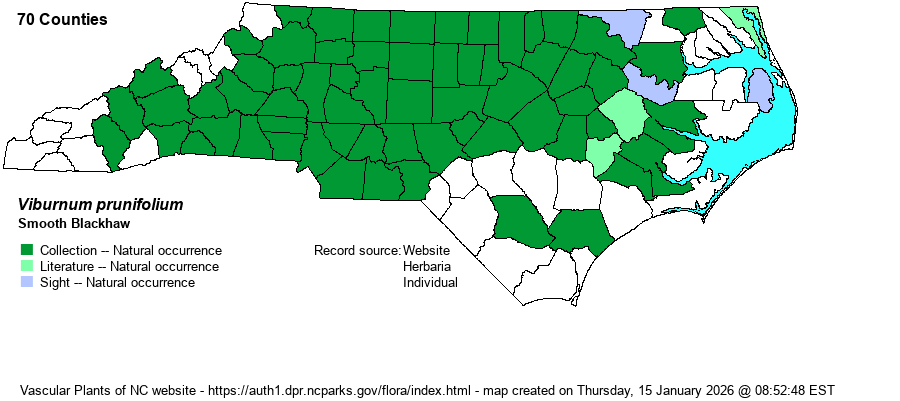| Author | L. | |
| Distribution | This species occurs throughout the Piedmont and the northwestern portion of the Coastal Plain. It is of spotty occurrence in the southeastern Coastal Plain and is absent from a number of far eastern counties. It is found in the Mountains mostly at lower elevations and seems to be absent from most northern counties. The species appears to be scarce or absent in the southwestern Mountains – about five counties in the corner of the state lack records.
This is a wide-ranging species from the Atlantic to the eastern edge of the Great Plains. However, it ranges north only to NY and IA and south only to the southern portions of GA and AL. It does not reach FL.
| |
| Abundance | Common in the Piedmont and is probably the most often encountered Viburnum species in the province. Fairly common to common at least locally in the northwestern Coastal Plain, but rare in the southeastern portions (except in rich soil areas). It can be fairly common in at least the central Mountain counties, but scarce in the north and in the southwestern corner. | |
| Habitat | This is a species of rich to mesic forested soil; it occurs in bottomlands, rich forested slopes, Basic Mesic Forests, oak-hickory forests, and other such slightly acidic to circumneutral soil forest types. In the southeastern Coastal Plain, it is perhaps limited to sites over marl and other high pH soils; however, farther to the west, it is not as limited to such circumneutral soils. |
| Phenology | Blooms in March and April, and fruits quite late – September to October. | |
| Identification | This is a fairly large deciduous shrub (rarely a small tree) growing to about 12-15 feet tall. It has opposite, mainly elliptical leaves that average about 2-2.5 inches long, with finely serrated margins. Vaccinium rufidulum has similar looking leaves, but V. prunifolium has thin leaves that are not overly shiny above and do not have rusty dots below; the other species has thick and very shiny leaves that are rusty-dotted below. The flowers are the standard Viburnum inflorescence of a broad, rounded cluster of small white flowers at the tips of branches, often blooming as the leaves are unfurling. | |
| Taxonomic Comments | A few older references listed a few varieties for the species, but most recent ones do not.
| |
| Other Common Name(s) | Black Haw (or Blackhaw), Nannyberry, Blackhaw Viburnum. Many references call it simply “Blackhaw”, but V. rufidulum is often also called “Blackhaw” or “Rusty Blackhaw”, and a modifier is warranted to avoid confusion. | |
| State Rank | S5 | |
| Global Rank | G5 | |
| State Status | | |
| US Status | | |
| USACE-agcp | FACU link |
| USACE-emp | FACU link |

